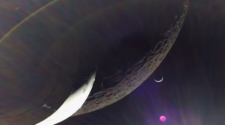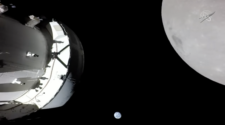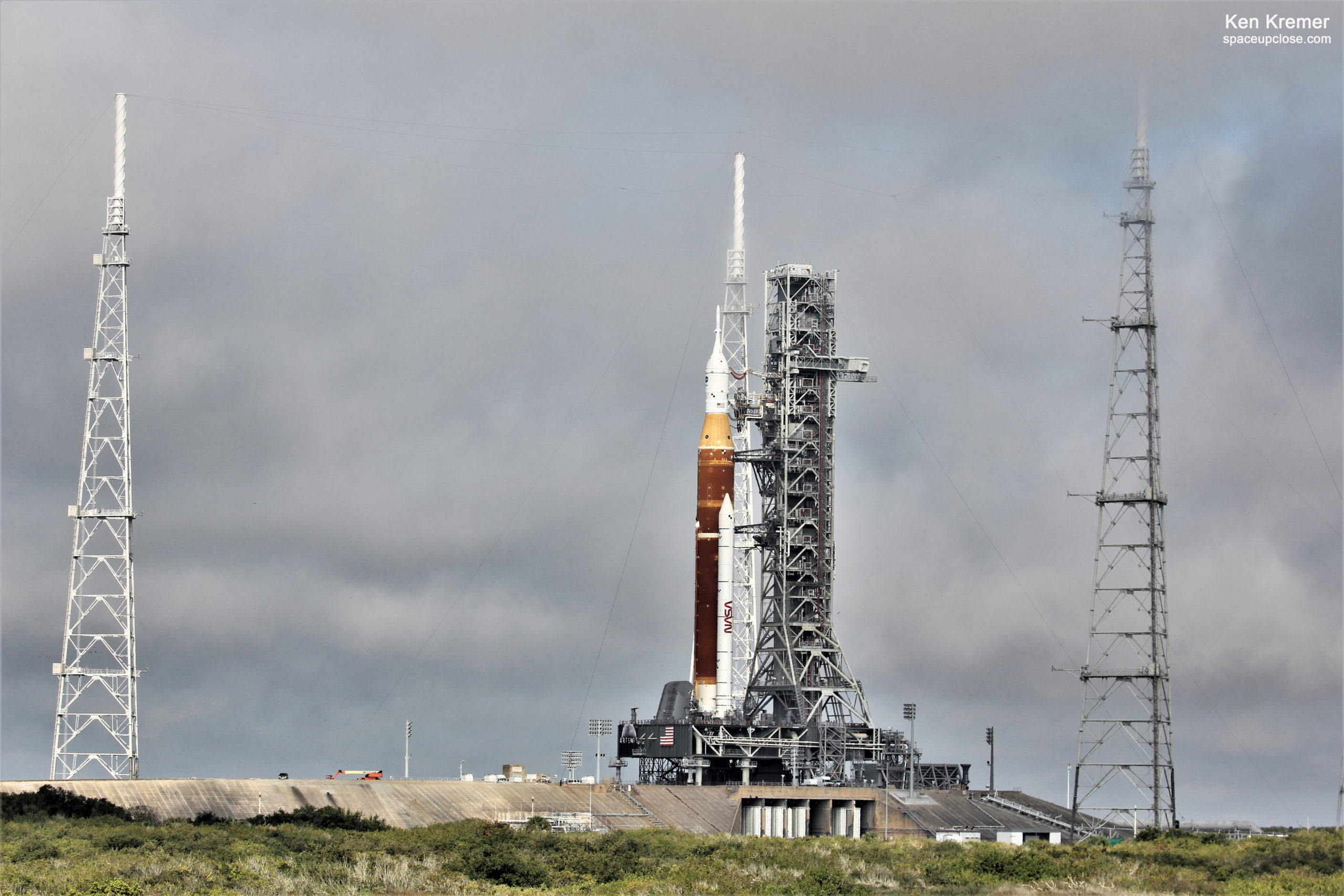 NASA’s Space Launch System (SLS) rocket with the Orion spacecraft aboard is seen atop Launch Complex 39B on March 18, 2022, after the first-ever rollout from the VAB the previous day. Prior to the Artemis 1 flight test, the fully stacked and integrated SLS rocket and Orion spacecraft will undergo a wet dress rehearsal (WDR) to verify systems and practice countdown procedures for the first launch slated for June 2022. Credit: Ken Kremer
NASA’s Space Launch System (SLS) rocket with the Orion spacecraft aboard is seen atop Launch Complex 39B on March 18, 2022, after the first-ever rollout from the VAB the previous day. Prior to the Artemis 1 flight test, the fully stacked and integrated SLS rocket and Orion spacecraft will undergo a wet dress rehearsal (WDR) to verify systems and practice countdown procedures for the first launch slated for June 2022. Credit: Ken KremerNASA’s first-ever Space Launch System (SLS) “mega moon” rocket topped by the Orion deep-space, crew-rated capsule stands proudly tall at its launchpad at the Kennedy Space Center (KSC) as of Friday morning, March 18, following its absolutely stunning ten-and-a-half hour roll out from the iconic Vehicle Assembly Building (VAB) on a four-mile trip commencing late Thursday afternoon, that truly begins the agency’s Project Artemis ‘Return to the Moon’ quest hearkening back to Project Apollo that landed the first humans on another celestial body more than half a century ago.
The integrated SLS and Orion stack will remain at Launch Complex 39B for several weeks to undergo a critical countdown and fueling test known as the wet dress rehearsal (WDR) in early April. The rocket stack will eventually launch on the history-making unpiloted Artemis 1 lunar mission as soon as June of this year.
Preparations for the two-day-long WDR test are going very well so far, according to NASA officials.
Following the arrival of the Space Launch System rocket and Orion spacecraft for Artemis 1 at Launch Pad 39B at NASA’s Kennedy Space Center in Florida on March 18, teams have connected numerous ground support equipment elements to the rocket and spacecraft, including electrical, fuel environmental control system ducts, and cryogenic propellant lines. All elements of the integrated system at the pad were powered up successfully for the first time on March 21 in preparation for the wet dress rehearsal test planned for the first week of April.
Engineering testing is underway now to ensure systems continue to operate as planned with the rocket and spacecraft now configured at the pad.
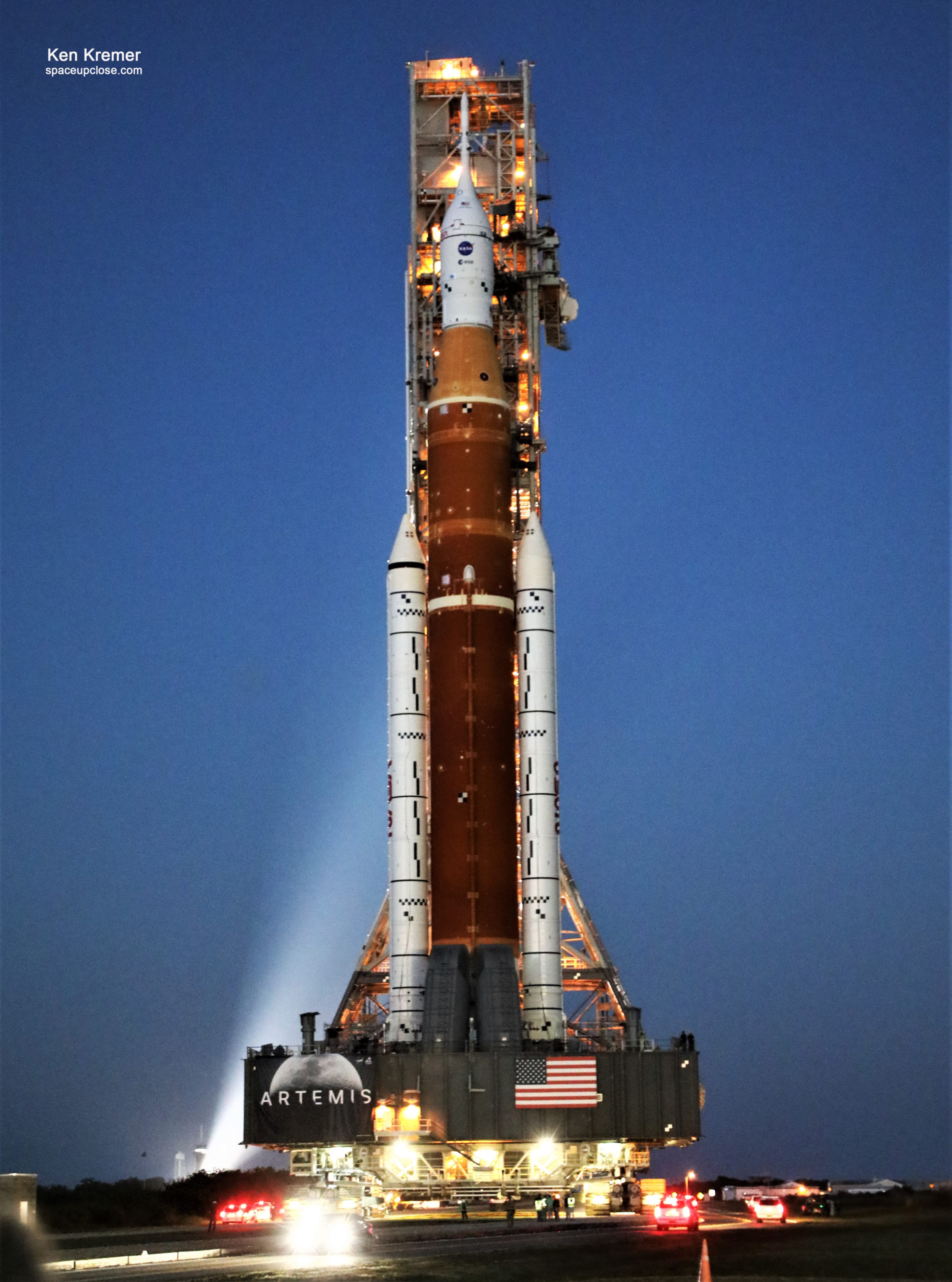 Spotlights shine toward NASA’s Space Launch System (SLS) rocket and the Orion spacecraft as they make their way slowly overnight from the Vehicle Assembly Building (VAB) to Launch Complex 39B for the first time ever on March 17, 2022. Credit: Ken Kremer
Spotlights shine toward NASA’s Space Launch System (SLS) rocket and the Orion spacecraft as they make their way slowly overnight from the Vehicle Assembly Building (VAB) to Launch Complex 39B for the first time ever on March 17, 2022. Credit: Ken KremerStacked on the mobile launcher and mounted on the crawler-transporter-2 (CT-2) for a journey from the Vehicle Assembly Building to Launch Pad 39B, it took 10 hours and 28 minutes for the 14.8-million-pound combined rocket stack to arrive at the launch pad 4.2 miles (6.8 km) away.
The 322-foot-tall (98 m) Artemis 1 stack arrived at Launch Complex-39B under dense fog at 4:15 a.m. EDT on Friday, March 18 on a momentous trip along the same crawler way that NASA’s Saturn V and Space Shuttle traveled across six different decades.
The upgraded crawler-transporter-2 (CT-2), originally built for NASA’s Apollo Moon landing program in the 1960s and 1970s, moved the stack at a maximum of 0.82 mph (1.3 kph) toward the pad.
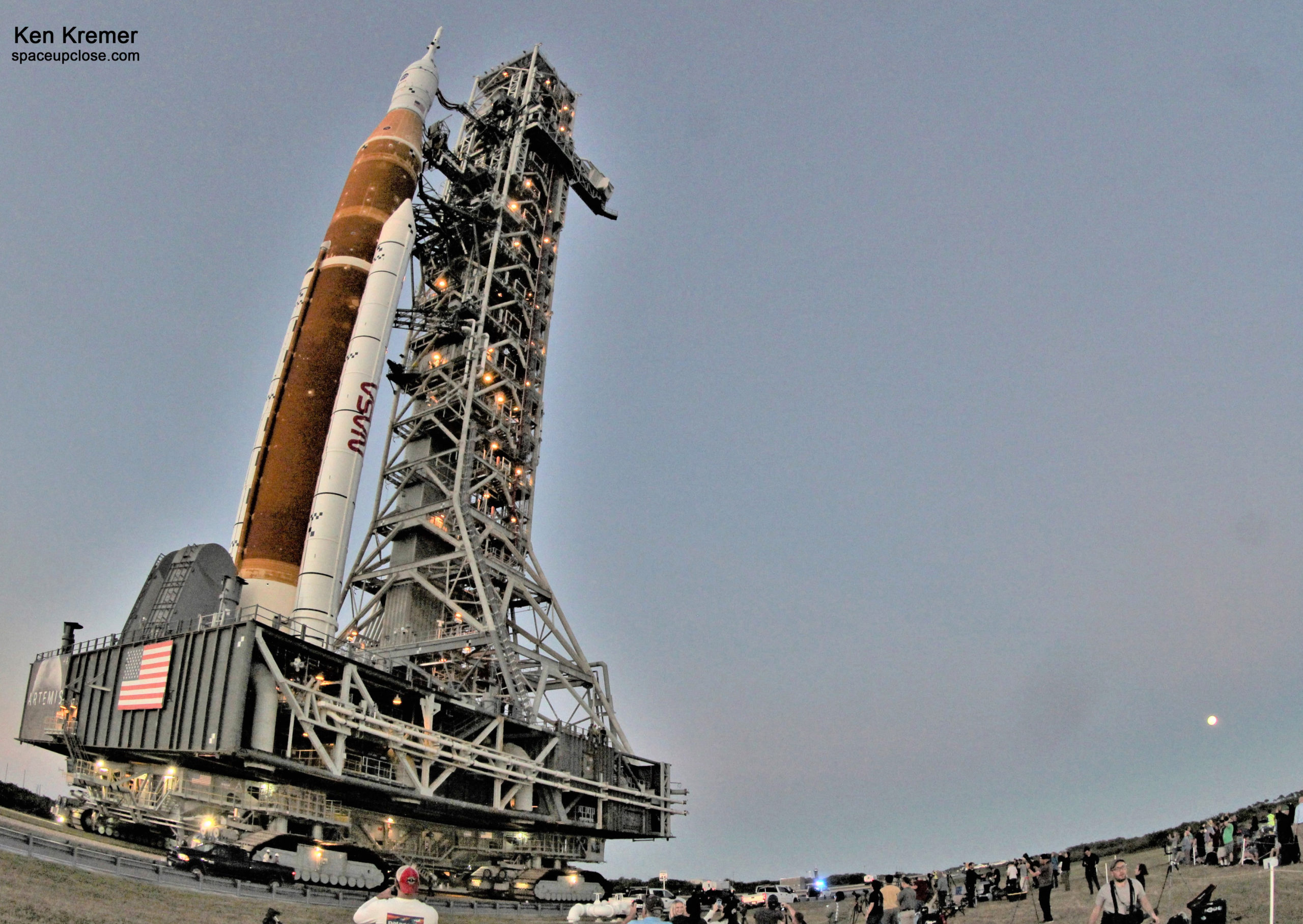 NASA’s Space Launch System (SLS) rocket and the Orion space capsule are seen atop the mobile launcher during rollout from the Vehicle Assembly Building with the Moon visible at (right) to Launch Complex 39B overnight on March 17, 2022. Credit: Ken Kremer
NASA’s Space Launch System (SLS) rocket and the Orion space capsule are seen atop the mobile launcher during rollout from the Vehicle Assembly Building with the Moon visible at (right) to Launch Complex 39B overnight on March 17, 2022. Credit: Ken KremerYears in the making, NASA’s SLS Moon rocket is destined to return American astronauts to the lunar surface later this decade for the first time in more than 50 years.
SLS is the most powerful rocket NASA has ever built, generating some 8.8 million pounds of liftoff thrust at ignition – about 15% more powerful than NASA’s legendary Saturn V that hurled the first humans to step foot on the Moon back in 1969 during the historic Apollo 11 mission.
The maiden SLS/Orion rocket rolled to the pad Thursday, March 17 for the critical WDR fueling and countdown demonstration test – which is the final major final fueling test before launch.
“From this sacred and historical place, humanity will soon embark on a new era of exploration,” said NASA administrator Bill Nelson. “Artemis I will demonstrate NASA’s commitment and capacity to extend humanity’s presence on the Moon – and beyond.”
Just days earlier technicians retracted the last two work platforms surrounding the 32-story-tall rocket inside the Vehicle Assembly Building (VAB) where its components have been assembled together over the past year.
The SLS stack was assembled in VAB High Bay 3 and the right side doors were opened late Thursday morning to expose the rocket for rollout to Launch Pad 39B.
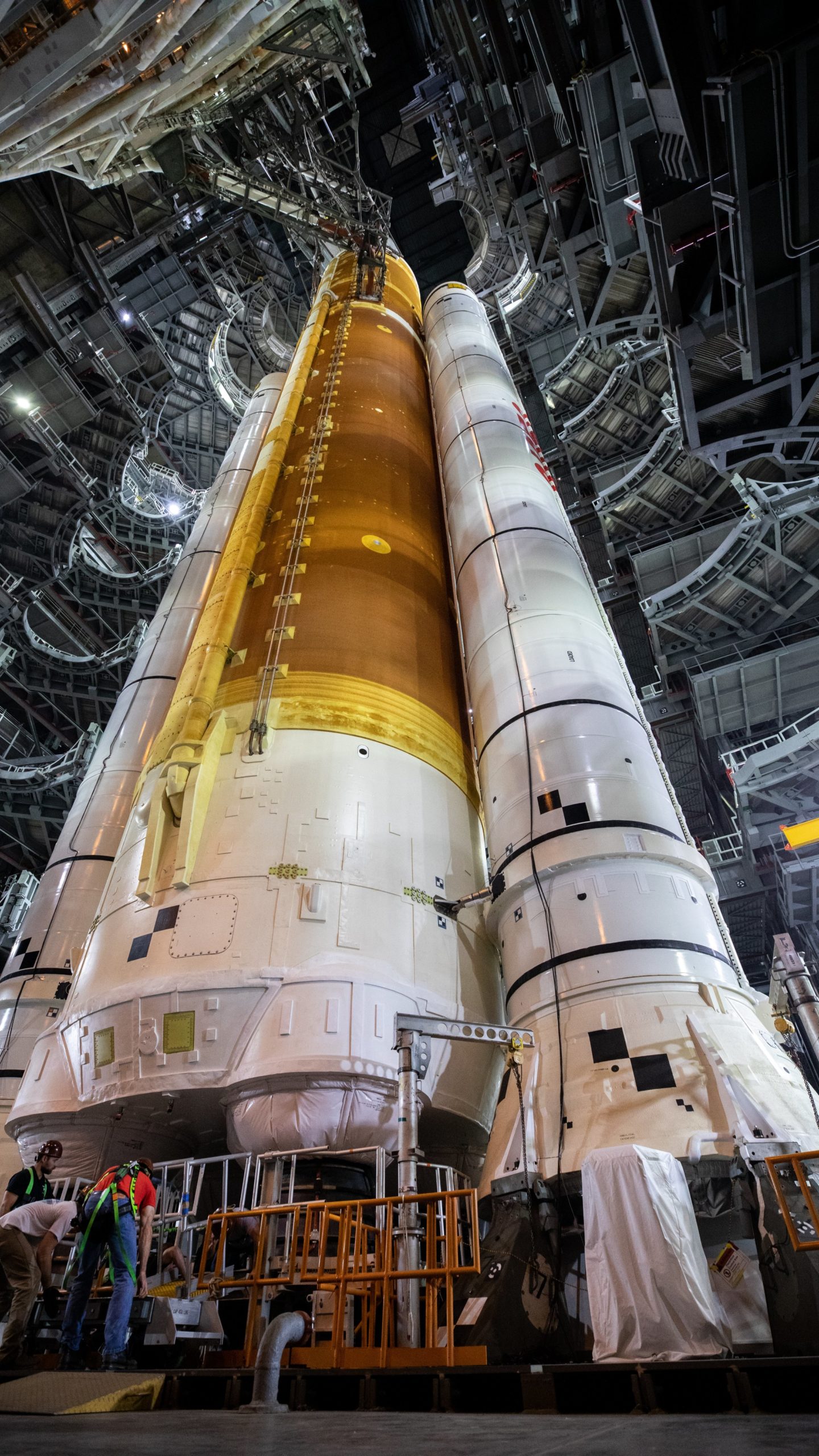 All of the work platforms that surround the Artemis 1 Space Launch System (SLS) and Orion spacecraft are fully retracted In this view from inside High Bay 3 of the VAB at Kennedy Space Center in Florida. Credit: NASA/Glenn Benson
All of the work platforms that surround the Artemis 1 Space Launch System (SLS) and Orion spacecraft are fully retracted In this view from inside High Bay 3 of the VAB at Kennedy Space Center in Florida. Credit: NASA/Glenn BensonThe rollout was broadcast live on NASA TV starting around 5 p.m. EDT on March 17
“At these launch pads, remarkable individuals achieve unthinkable things,” Administrator Nelson said during NASA’s live rollout broadcast at KSC. “Today, a new generation — not the Apollo generation, but it’s the Artemis generation — is preparing to reach new frontiers. This generation will return astronauts to the moon, and this time, we will land the first woman and the first person of color on the surface to conduct groundbreaking science.”
“NASA’s Artemis program will pave the way for humanity’s giant leap — future missions to Mars,” Nelson added. “There is no doubt we are in a golden era of human space exploration, discovery, and ingenuity in space. And it all begins with Artemis 1.
“Artemis 1 will demonstrate NASA’s commitment and capacity to extend humanity’s presence on the moon and beyond.”
SLS serves as the backbone of the Artemis program and the nation’s future deep-space exploration missions.
Overall, SLS stands 322 feet (98 meters) tall and weighs 5.75 million pounds.
Here are some up-close photos NASA tweeted of Orion atop SLS at Launch Pad 39B.
https://twitter.com/NASA_Orion/status/1506729076924596224
Here are some photos NASA tweeted of the SLS/Orion stack at Launch Pad 39B at sunrise on March 23.
https://twitter.com/NASA_SLS/status/1506616850519674880
During the wet dress rehearsal, the Artemis 1 launch team will run through operations to load propellant into the rocket’s tanks, conduct a full launch countdown, demonstrate the ability to recycle the countdown clock, and also drain the tanks to practice the timelines and procedures the team will use for launch.
The WDR is currently targeted for April 3. The call to stations is expected on April 1 for the two-day test.
Both stages of SLS will be fueled during the WDR. The stages will be fueled with cryogenic liquid oxygen (LOX) and liquid hydrogen (LH2) starting around 7 a.m. EDT on WDR test day.
Following a successful WDR campaign, the SLS/Orion will roll back to the VAB for final checkouts and refurbishments before the Artemis 1 launch campaign commences.
NASA will announce a target launch date for Artemis 1 after thoroughly analyzing all the WDR test results.
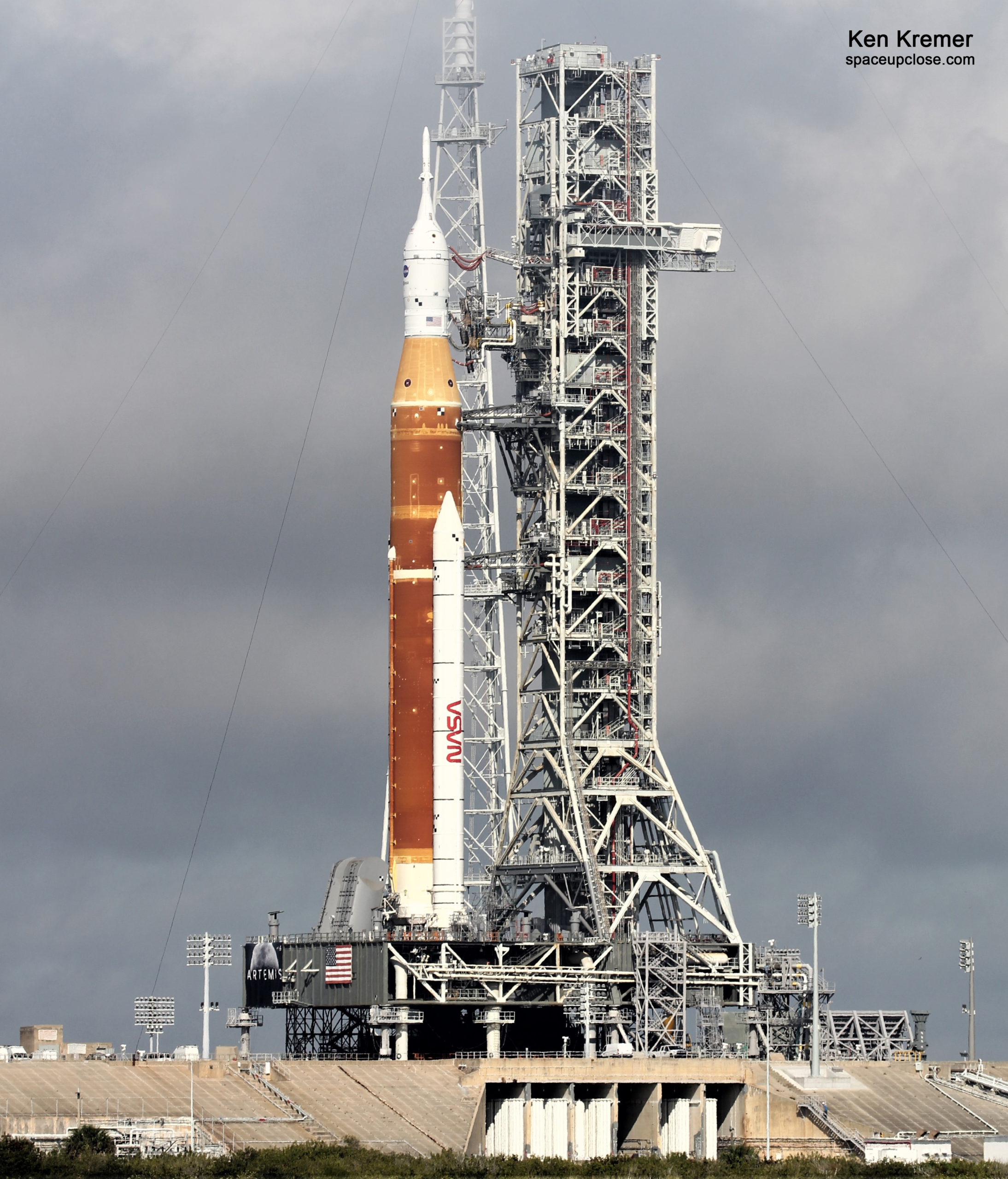 Dense fog enveloped the SLS rocket and only cleared late in the morning to unveil the 32-story-tall beast atop Launch Pad 39B. Credit: Ken Kremer
Dense fog enveloped the SLS rocket and only cleared late in the morning to unveil the 32-story-tall beast atop Launch Pad 39B. Credit: Ken Kremer“The approximately two-day wet dress rehearsal test will demonstrate the team’s ability to load cryogenic, or super-cold, propellants into the rocket, conduct a launch countdown, and practice safely removing propellants at the launch pad. After the wet dress rehearsal, engineers will roll the rocket and spacecraft back to the Vehicle Assembly Building for final checkouts before launch,” said NASA in the March 23 blog update.
The uncrewed Artemis 1 flight test will pave the way for the Artemis 3 mission to land the first woman and first person of color on the Moon under Project Artemis.
NASA is still targeting the launch of Artemis 3 as early as 2025.
Liftoff of the uncrewed Artemis 1 mission is slated for no earlier than June 2022 from Launch Complex 39B at NASA KSC on the first in a series of increasingly complex missions to test the SLS heavy lift rocket and Orion crew capsule as an integrated system prior to crewed flights to the Moon starting with Artemis 2 – targeting launch in 2024.
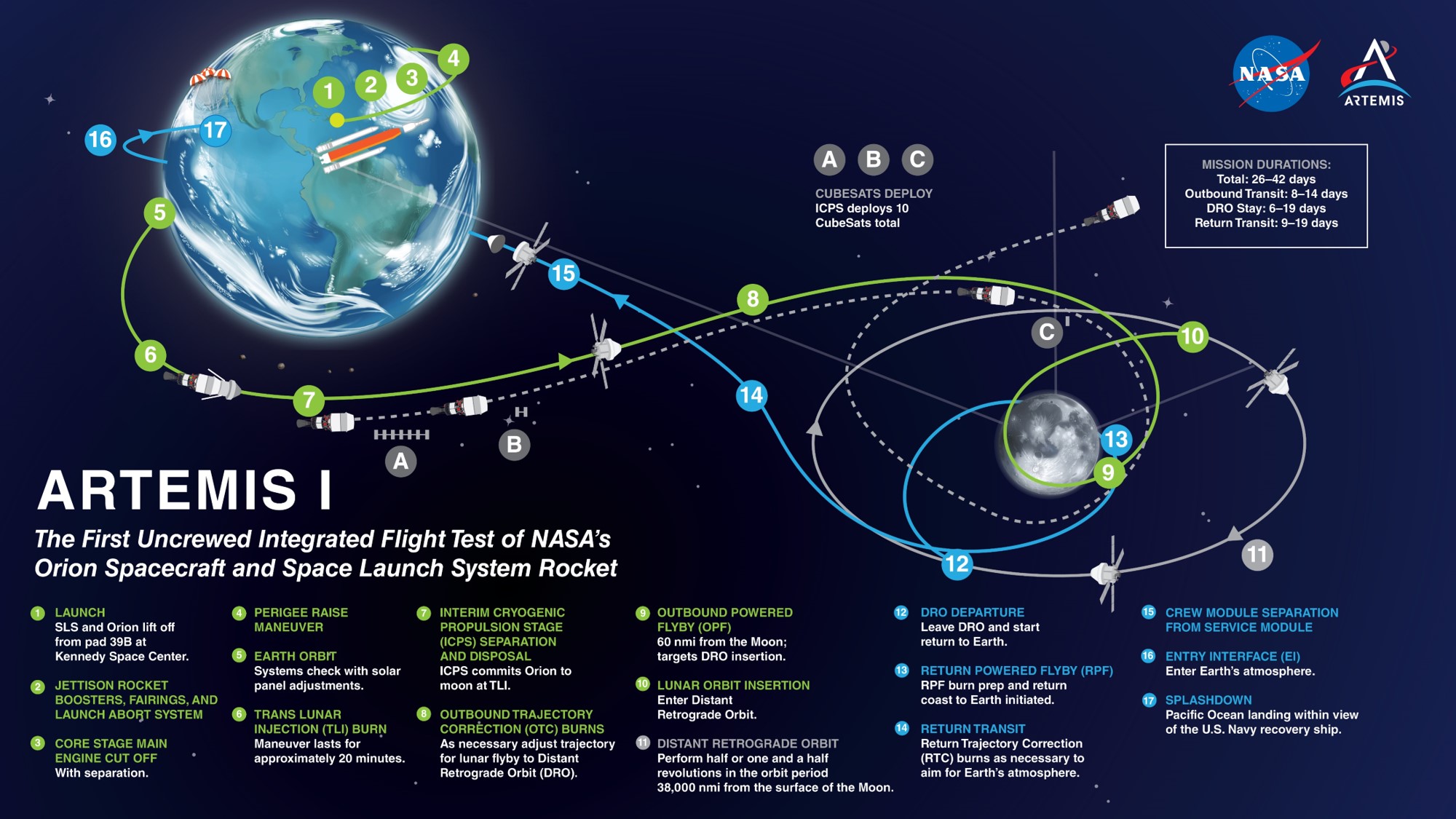 This NASA infographic shows the trajectory and timeline for the first Artemis uncrewed lunar mission. Artemis 1 will serve as an integrated flight test of NASA’s deep space exploration system: the Orion spacecraft, Space Launch System (SLS) rocket, and the ground systems at Kennedy Space Center in Cape Canaveral, Florida. Credit: NASA
This NASA infographic shows the trajectory and timeline for the first Artemis uncrewed lunar mission. Artemis 1 will serve as an integrated flight test of NASA’s deep space exploration system: the Orion spacecraft, Space Launch System (SLS) rocket, and the ground systems at Kennedy Space Center in Cape Canaveral, Florida. Credit: NASASLS 1 will launch the Orion crew spacecraft on the Artemis 1 mission lasting between four to six weeks on a journey 280,000 miles (450,000 kilometers) from Earth to beyond the Moon and then return to Earth.
A crew of four NASA and Canadian astronauts will fly aboard Artemis 2 in 2024 in the Orion capsule on the first crewed mission to the Moon in more than 50 years
SLS was built by prime contractor Boeing at NASA’s Michoud Assembly Facility in New Orleans. Orion was built by prime contractor Lockheed Martin at the Kennedy Space Center.

